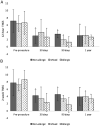Evaluation of In-Office Cryoablation of Posterior Nasal Nerves for the Treatment of Rhinitis
- PMID: 33598336
- PMCID: PMC7863162
- DOI: 10.1177/2152656720988565
Evaluation of In-Office Cryoablation of Posterior Nasal Nerves for the Treatment of Rhinitis
Abstract
Background: Chronic rhinitis is a common condition generally treated with medical therapies. However, 10-22% of patients are refractory to medical therapies. A cryotherapy handheld device targeting the postganglionic nerve fibers of the posterior nasal nerve (PNN) now serves as an additional option for therapy. This study evaluates the efficacy of the cryosurgical ablation device of the PNN in the clinic setting.
Methods: This was a prospective single-arm trial of 24 adult patients at seven locations within a large health maintenance organization. Patients with chronic rhinitis that failed medical therapy were offered an in-office cryoablation of PNN. Patients completed the Total Nasal Symptom Score (TNSS) questionnaire consisting of 5 items reported based on the previous 12 hours and 2 weeks at the following time points: pre-treatment, 30 days, 90 days and 1 year post-treatment.
Results: Following cryoablation of the PNN, the TNSS 12-hour symptom score improved from 6.92 (±2.9) to 3.17 (±2.4, P < 0.001) at 30 days, 2.92 (±1.4, P < 0.001) at 90 days and 3.08 (±2.6, P < 0.001) at 1 year post treatment. Similar results were noted for the 2 weeks scores improving from 7.75 (±3.1) to 3.79 (±2.1, P < 0.001) at 30 days, 3.88 (±1.9, P < 0.001) at 90 days and 3.76 (±2.1, P < 0.001) at 1 year post-treatment. 64.7% of respondents stated the procedure decreased or eliminated nasal sprays.
Conclusions: Our independent evaluation of cryoablation of the PNN shows improvement in nasal symptoms over a 1 year period and is consistent with other published data.
Keywords: congestion; cryoablation; cryosurgery; cryosurgical ablation; posterior nasal nerve; rhinitis; rhinorrhea.
© The Author(s) 2021.
Conflict of interest statement
Declaration of Conflicting Interests: The author(s) declared no potential conflicts of interest with respect to the research, authorship, and/or publication of this article.
Figures




References
-
- Settipane RA. Rhinitis: a dose of epidemiological reality. Allergy Asthma Proc. 2003; 24(3):147–154. - PubMed
-
- Lieberman P, Kaliner MA, Wheeler WJ. Open-label evaluation of azelastine nasal spray in patients with seasonal allergic rhinitis and nonallergic vasomotor rhinitis. Curr Med Res Opin. 2005; 21(4):611–618. doi:10.1185/030079905X41408 - PubMed
LinkOut - more resources
Full Text Sources
Other Literature Sources

